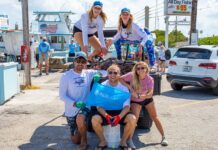The Monroe County Tourist Development Council wants unallocated capital resource money to be used for advertising the Florida Keys.
Before 2017, any unallocated building project money, unused capital, was “swept” into the advertising fund. But last year, the Monroe County Commission, which governs the Tourist and Development Council, made two significant changes to how bed tax money is spent.
One, municipal and nonprofit projects would be reimbursed at a higher rate — 100 percent for cities, 75 percent for nonprofits. And, two, unused capital could not roll over unless there was a special case.
Apparently, Hurricane Irma qualifies as that special case.


In a letter to its advisory committees in February, TDC Chairperson Rita Irwin, Marketing Director Kelli Fountain, and Office Manager Maxine Pacini expressed an intention to make the advertising request, and asked the five committees to vote independently on the decision to go forward with the request.
“I have to hear more justification for this,” said Monroe County Commissioner Danny Kolhage leading up to the meeting. “I’m not sure that we’ve allowed enough time for recovery, to see how the revenue comes in. I want to discuss that at the meeting on Wednesday.”
Each requested amount is based on the percent of bed tax revenue each of the five districts are down from January 2017 figures. Because current reports take months to complete, December revenue reports were used as benchmarks. According to the council’s March Four Penny Revenue report, Monroe County as a whole is down 20.3 percent in revenue earnings. The five districts show vast disparity, however.
District 1, Key West is down 14.1 percent. District 2, the Lower Keys, is down 15 percent. Marathon, District 3, is down 30.3 percent. The most affected area, Islamorada or District 4, is down 62.6 percent. District 5, Tavernier and Key Largo, is only down 8.6 percent.
So, for example, in DAC 5 (Key Largo), there is about $513,000 in unallocated funds. Using the percentage proposed by TDC, 8.6 percent or approximately $44,000 would be used for advertising instead of brick and mortar projects.
That, however, is planning for an uncertain future. According to the TDC’s own numbers, the county is already making a strong recovery as a tourist destination. How much to spend on Times Square advertising in, say, October of next year is anybody’s guess.
“What was nice about the way it was re-written was that there was a clause that each district could also ask for consideration to reallocate money,” said Irwin. “Here we have a storm that affected the five districts differently.”
In District 4 (Islamorada,) the case for rolling over the money was the obvious choice. Lodging has been the primary reason revenue numbers are down. With just over half of its 1,300 lodging rooms available, the district needed to have a plan for a budget, said District 4 Advisory Committee Chair Patti Stanley.
“We had the highest percentage of hotel rooms out of commission and have seen the high percentage of bed tax revenue loss. That’s our pot of money for advertisement, so we were looking at nothing coming in for next year,” said Stanley.

District 3, Marathon, voted to request funds be considered for reallocation. Marathon Mayor Michelle Coldiron, who sits on the DAC board, cast a dissenting vote. Coldiron said the money originally budgeted for bricks and mortar should stay in bricks and mortar.
“I completely understand that after the hurricane we need advertisement. However, I also believe the money from bricks and mortar could help recover the beaches and provide money for infrastructure so that when a tourist comes here they have a positive experience,” said Coldiron.
Bed tax revenue numbers are slowly improving. From December 2017 to January 2018, District 3’s earnings recovered by 6 percent. Having money for future capital improvements could improve both tourist impressions and local morale, she said.
“I empathize with both sides; however, the City of Marathon actually pulled projects and didn’t ask for bricks and mortar money several months ago, realizing money was tight. Yet we have Coco Plum Beach and Sombrero Beach that could benefit from that money, as well as some of our non-profits,” said Coldiron.
Following the hurricane, the tourist council had allocated $1 million for emergency capital funding and for emergency advertisement. According to the tourist council’s director, Stacey Mitchell, those advertisement dollars have been exhausted.



























